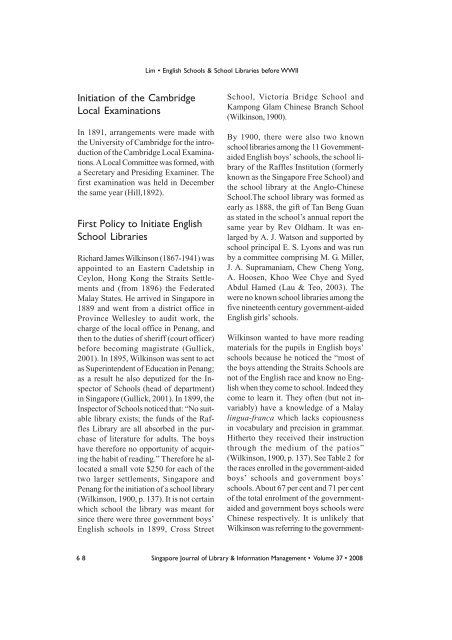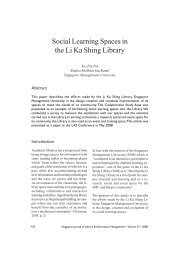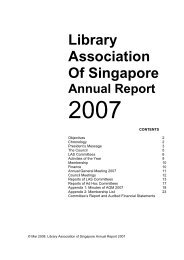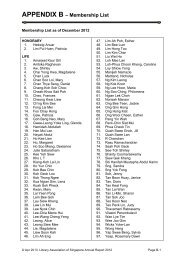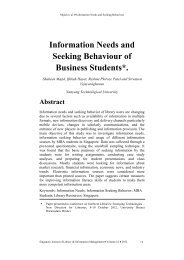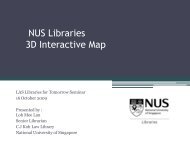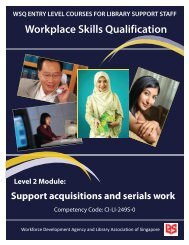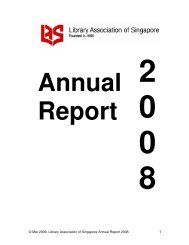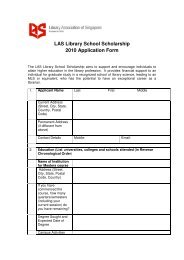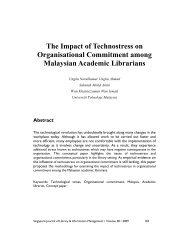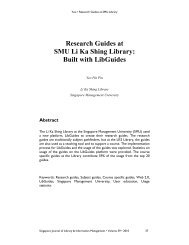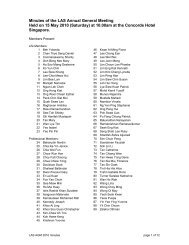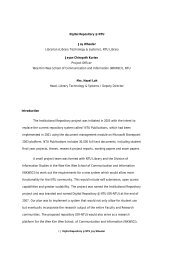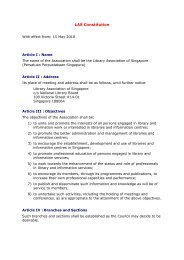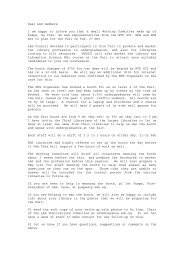English Schools and School - Library Association of Singapore
English Schools and School - Library Association of Singapore
English Schools and School - Library Association of Singapore
You also want an ePaper? Increase the reach of your titles
YUMPU automatically turns print PDFs into web optimized ePapers that Google loves.
Initiation <strong>of</strong> the Cambridge<br />
Local Examinations<br />
Lim • <strong>English</strong> <strong><strong>School</strong>s</strong> & <strong>School</strong> Libraries before WWII<br />
In 1891, arrangements were made with<br />
the University <strong>of</strong> Cambridge for the introduction<br />
<strong>of</strong> the Cambridge Local Examinations.<br />
A Local Committee was formed, with<br />
a Secretary <strong>and</strong> Presiding Examiner. The<br />
first examination was held in December<br />
the same year (Hill,1892).<br />
First Policy to Initiate <strong>English</strong><br />
<strong>School</strong> Libraries<br />
Richard James Wilkinson (1867-1941) was<br />
appointed to an Eastern Cadetship in<br />
Ceylon, Hong Kong the Straits Settlements<br />
<strong>and</strong> (from 1896) the Federated<br />
Malay States. He arrived in <strong>Singapore</strong> in<br />
1889 <strong>and</strong> went from a district <strong>of</strong>fice in<br />
Province Wellesley to audit work, the<br />
charge <strong>of</strong> the local <strong>of</strong>fice in Penang, <strong>and</strong><br />
then to the duties <strong>of</strong> sheriff (court <strong>of</strong>ficer)<br />
before becoming magistrate (Gullick,<br />
2001). In 1895, Wilkinson was sent to act<br />
as Superintendent <strong>of</strong> Education in Penang;<br />
as a result he also deputized for the Inspector<br />
<strong>of</strong> <strong><strong>School</strong>s</strong> (head <strong>of</strong> department)<br />
in <strong>Singapore</strong> (Gullick, 2001). In 1899, the<br />
Inspector <strong>of</strong> <strong><strong>School</strong>s</strong> noticed that: “No suitable<br />
library exists; the funds <strong>of</strong> the Raffles<br />
<strong>Library</strong> are all absorbed in the purchase<br />
<strong>of</strong> literature for adults. The boys<br />
have therefore no opportunity <strong>of</strong> acquiring<br />
the habit <strong>of</strong> reading.” Therefore he allocated<br />
a small vote $250 for each <strong>of</strong> the<br />
two larger settlements, <strong>Singapore</strong> <strong>and</strong><br />
Penang for the initiation <strong>of</strong> a school library<br />
(Wilkinson, 1900, p. 137). It is not certain<br />
which school the library was meant for<br />
since there were three government boys’<br />
<strong>English</strong> schools in 1899, Cross Street<br />
<strong>School</strong>, Victoria Bridge <strong>School</strong> <strong>and</strong><br />
Kampong Glam Chinese Branch <strong>School</strong><br />
(Wilkinson, 1900).<br />
By 1900, there were also two known<br />
school libraries among the 11 Governmentaided<br />
<strong>English</strong> boys’ schools, the school library<br />
<strong>of</strong> the Raffles Institution (formerly<br />
known as the <strong>Singapore</strong> Free <strong>School</strong>) <strong>and</strong><br />
the school library at the Anglo-Chinese<br />
<strong>School</strong>.The school library was formed as<br />
early as 1888, the gift <strong>of</strong> Tan Beng Guan<br />
as stated in the school’s annual report the<br />
same year by Rev Oldham. It was enlarged<br />
by A. J. Watson <strong>and</strong> supported by<br />
school principal E. S. Lyons <strong>and</strong> was run<br />
by a committee comprising M. G. Miller,<br />
J. A. Supramaniam, Chew Cheng Yong,<br />
A. Hoosen, Khoo Wee Chye <strong>and</strong> Syed<br />
Abdul Hamed (Lau & Teo, 2003). The<br />
were no known school libraries among the<br />
five nineteenth century government-aided<br />
<strong>English</strong> girls’ schools.<br />
Wilkinson wanted to have more reading<br />
materials for the pupils in <strong>English</strong> boys’<br />
schools because he noticed the “most <strong>of</strong><br />
the boys attending the Straits <strong><strong>School</strong>s</strong> are<br />
not <strong>of</strong> the <strong>English</strong> race <strong>and</strong> know no <strong>English</strong><br />
when they come to school. Indeed they<br />
come to learn it. They <strong>of</strong>ten (but not invariably)<br />
have a knowledge <strong>of</strong> a Malay<br />
lingua-franca which lacks copiousness<br />
in vocabulary <strong>and</strong> precision in grammar.<br />
Hitherto they received their instruction<br />
through the medium <strong>of</strong> the patios”<br />
(Wilkinson, 1900, p. 137). See Table 2 for<br />
the races enrolled in the government-aided<br />
boys’ schools <strong>and</strong> government boys’<br />
schools. About 67 per cent <strong>and</strong> 71 per cent<br />
<strong>of</strong> the total enrolment <strong>of</strong> the governmentaided<br />
<strong>and</strong> government boys schools were<br />
Chinese respectively. It is unlikely that<br />
Wilkinson was referring to the government-<br />
6 8 <strong>Singapore</strong> Journal <strong>of</strong> <strong>Library</strong> & Information Management • Volume 37 • 2008


